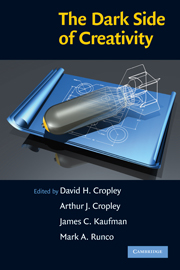Book contents
- Frontmatter
- Contents
- List of Contributors
- 1 The Dark Side of Creativity: What Is It?
- 2 Creativity Has No Dark Side
- 3 Positive Creativity and Negative Creativity (and Unintended Consequences)
- 4 Subjugating the Creative Mind: The Soviet Biological Weapons Program and the Role of the State
- 5 Imagining the Bomb: Robert Oppenheimer, Nuclear Weapons, and the Assimilation of Technological Innovation
- 6 The Innovation Dilemma: Some Risks of Creativity in Strategic Agency
- 7 Early Creativity as a Constraint on Future Achievement
- 8 Boundless Creativity
- 9 Reviewing the Art of Crime: What, If Anything, Do Criminals and Artists/Designers Have in Common?
- 10 Creativity in Confinement
- 11 Creativity and Crime: How Criminals Use Creativity to Succeed
- 12 So You Want to Become a Creative Genius? You Must Be Crazy!
- 13 Both Sides of the Coin? Personality, Deviance, and Creative Behavior
- 14 Neurosis: The Dark Side of Emotional Creativity
- 15 Dangling from a Tassel on the Fabric of Socially Constructed Reality: Reflections on the Creative Writing Process
- 16 Creativity in the Classroom: The Dark Side
- 17 The Dark Side of Creativity and How to Combat It
- 18 A Systems Engineering Approach to Counterterrorism
- 19 Malevolent Innovation: Opposing the Dark Side of Creativity
- 20 Summary – The Dark Side of Creativity: A Differentiated Model
- Index
- References
8 - Boundless Creativity
Published online by Cambridge University Press: 05 June 2012
- Frontmatter
- Contents
- List of Contributors
- 1 The Dark Side of Creativity: What Is It?
- 2 Creativity Has No Dark Side
- 3 Positive Creativity and Negative Creativity (and Unintended Consequences)
- 4 Subjugating the Creative Mind: The Soviet Biological Weapons Program and the Role of the State
- 5 Imagining the Bomb: Robert Oppenheimer, Nuclear Weapons, and the Assimilation of Technological Innovation
- 6 The Innovation Dilemma: Some Risks of Creativity in Strategic Agency
- 7 Early Creativity as a Constraint on Future Achievement
- 8 Boundless Creativity
- 9 Reviewing the Art of Crime: What, If Anything, Do Criminals and Artists/Designers Have in Common?
- 10 Creativity in Confinement
- 11 Creativity and Crime: How Criminals Use Creativity to Succeed
- 12 So You Want to Become a Creative Genius? You Must Be Crazy!
- 13 Both Sides of the Coin? Personality, Deviance, and Creative Behavior
- 14 Neurosis: The Dark Side of Emotional Creativity
- 15 Dangling from a Tassel on the Fabric of Socially Constructed Reality: Reflections on the Creative Writing Process
- 16 Creativity in the Classroom: The Dark Side
- 17 The Dark Side of Creativity and How to Combat It
- 18 A Systems Engineering Approach to Counterterrorism
- 19 Malevolent Innovation: Opposing the Dark Side of Creativity
- 20 Summary – The Dark Side of Creativity: A Differentiated Model
- Index
- References
Summary
From an open-minded perspective of creativity knowing no bounds, this chapter discusses some darker aspects of creativity and the role of ethics in responsible design practice and considers the potential need to engage with unethical perspectives in order to “design” more responsibly. This chapter also describes how “Cyclic Countering of Competitive Creativity” (C4), as a critical design process, enables effective engagement with the likes of crime and terrorism.
The intention is to first discuss perspectives on the darker side of creativity in recognition of there being naturalness to it that comes as a condition of human beings' reflexive use of knowledge and to propose that the value of the perceived “good and evil” achieved through creativity is in its balance. This includes an acknowledgment that worldviews and our use and abuse of socioeconomic and technological opportunities can tip that balance in ways that create a need to correct through cessation or redirective practices (Willis, 2008).
When there are no bounds to creativity, creative processes may equally identify and apply opportunities for good or evil, although the concept of good and evil is a human construct relating to helping or harming. We may claim that conscious perception of good and evil enables virtuous behavior, yet either outcome may be achieved by either thoughtful or thoughtless responses to opportunity in more complex situations. At times, to appreciate the nature of a given situation, an understanding of consequences requires higher levels of thinking – systems thinking (Checkland, 1981).
- Type
- Chapter
- Information
- The Dark Side of Creativity , pp. 134 - 154Publisher: Cambridge University PressPrint publication year: 2010
References
- 3
- Cited by



